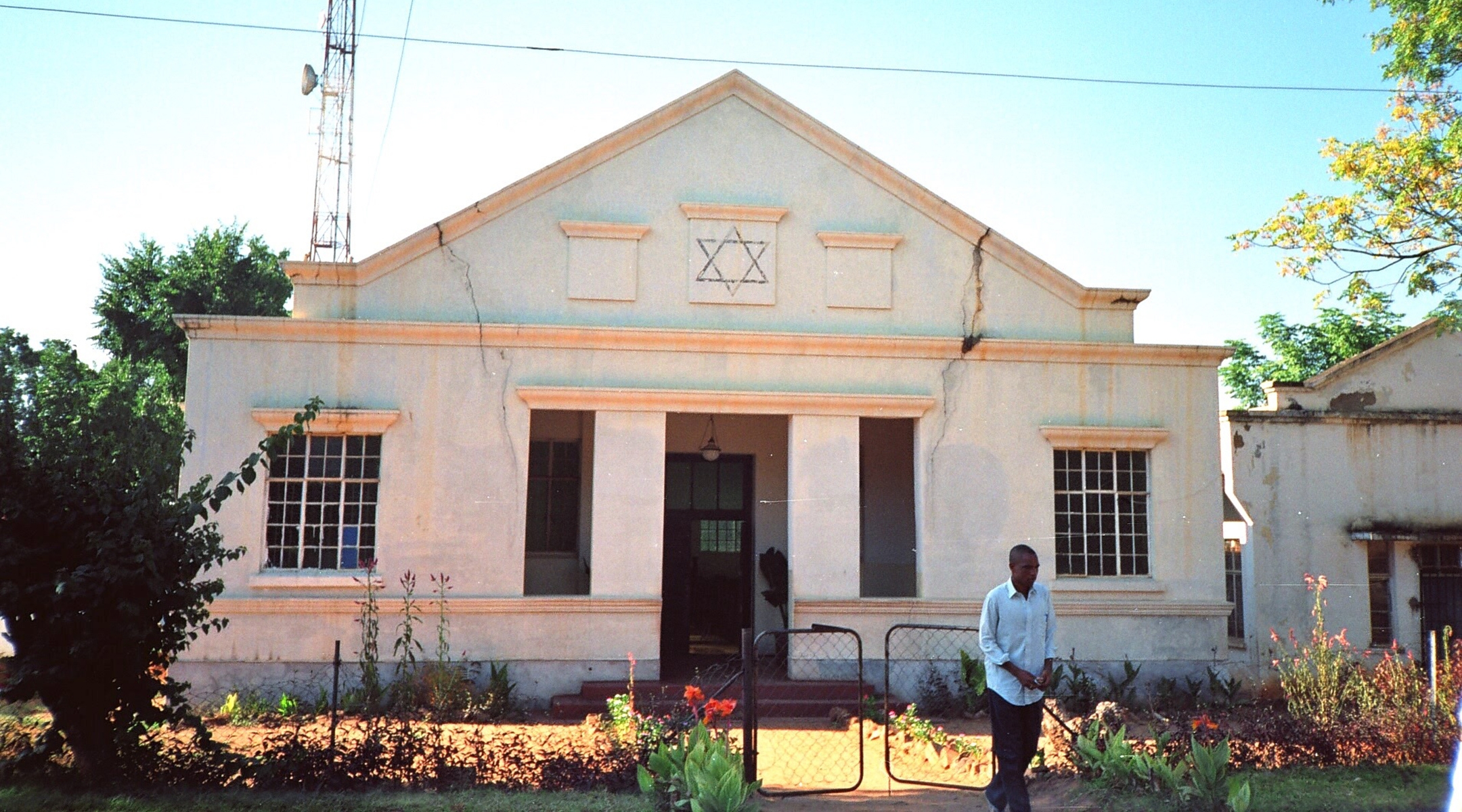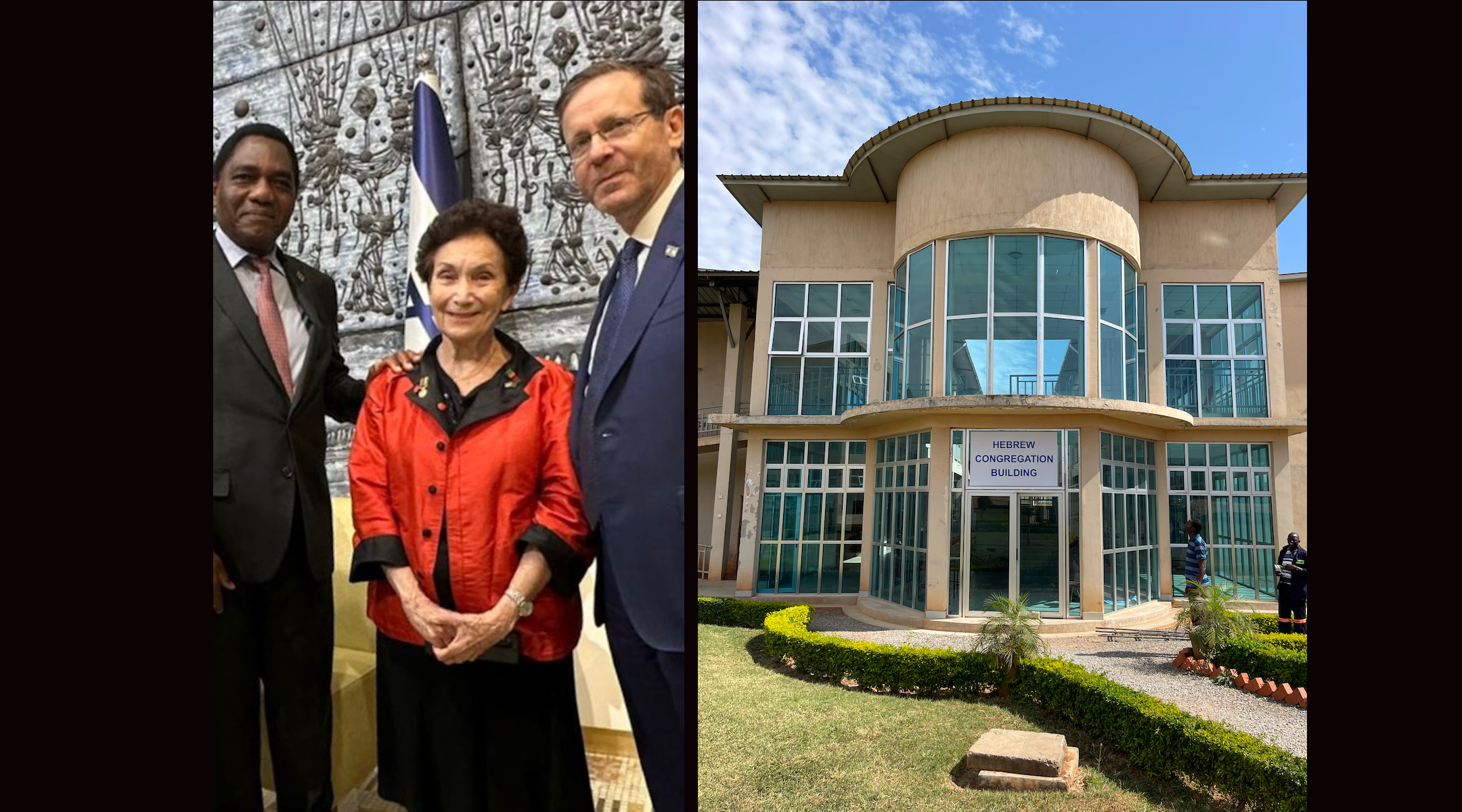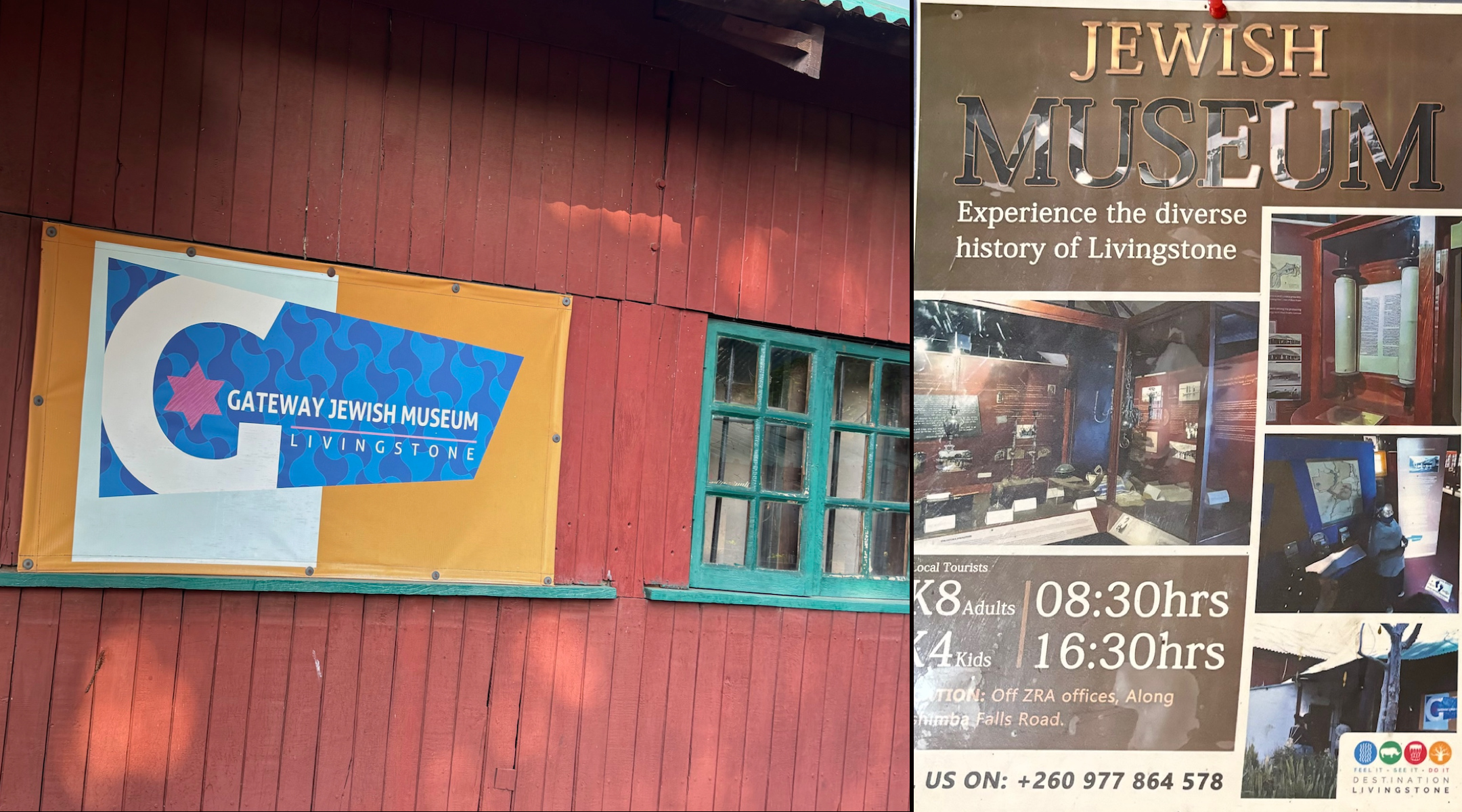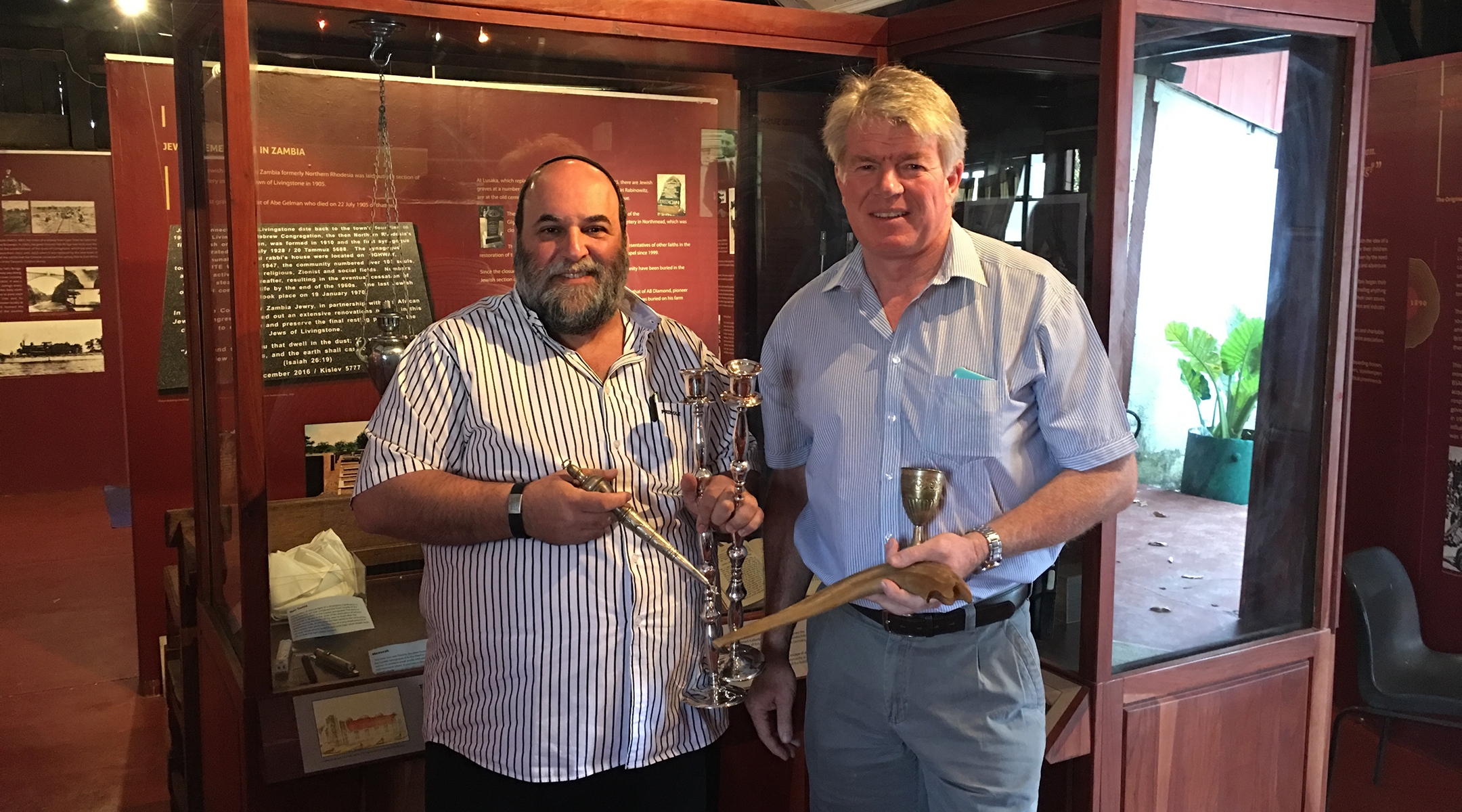A railway museum in Zambia offers a clue to the African country’s rich Jewish history
Today, there are almost no Jews living in Zambia, a nation of about 20 million in central Africa. But the influence of their historic presence is continuing to shape the developing nation, particularly as it builds up its medical infrastructure

The former synagogue of Livingstone, Zambia, is used today as a church. (Courtesy Rabbi Moshe Silberhaft)
LIVINGSTONE, Zambia — On the outskirts of this frontier town about seven miles from spectacular Victoria Falls, a wooden building marked “Gateway Jewish Museum” stands amidst 100-year old steam locomotives and vintage coaches showcasing the railway industry of the country.
There’s no doubt railways were key to the development of landlocked Zambia. But Jews?
“A tiny population influential beyond its numbers,” is how Oxford historian Hugh Macmillan described this community, which at its postwar peak numbered no more than 1,200.
“Jews have played an important part in Zambian history, especially in commercial business but also in the country’s political and intellectual life,” said Macmillan, co-author of the 1999 book “Zion in Africa: The Jews of Zambia.”
Today, there are almost no Jews living in Zambia, a nation of about 20 million in central Africa. But the influence of their historic presence is continuing to shape the developing nation, particularly as it builds up its medical infrastructure.
European Jews first came to the country in the late 19th century, when it was still known as Northern Rhodesia. Most were from Eastern Europe’s “Pale of Settlement” — poor Yiddish-speaking emigrants seeking a better life. They started off as peddlers, traders and shopkeepers. Over the next few decades, they diversified into farming, cattle ranching, timber and mining.
In the 1920s, about 100 Jews lived in the country, nearly half of them in Livingstone, then the capital city. The second wave of Jewish immigration occurred in the late 1930s, when some 300 Jews from Germany and Austria — along with others from Latvia, Lithuania and the Greek island of Rhodes — received visas from the British colonial regime. Many more, fleeing Nazi persecution, were denied entry.

Left: Aviva Ron, center, with President of Zambia Hakainde Hichilema and Israeli President Isaac Herzog, in Israel, August 2023. (Courtesy Ron) R: Hebrew Congregation Building at Copperbelt University Medical School was built with donations from Zambia’s departed Jewish community. (Harry Wall)
As Zambia developed its copper mines in the north, the Jewish population swelled; communities began popping up in the “Copperbelt” towns of Kitwe, Ndola, Mufulira and the new capital, Lusaka. Each of these towns had its own synagogue, celebrated religious holidays and had a Jewish cemetery.
“We were a small but very cohesive community,” said Aviva Ron, 81, who grew up in Ndola. Her father, Hanania Elkaim, came to Northern Rhodesia from pre-state Palestine and was in the construction business.
“We had services every Friday night. Bar mitzvahs were prepared by a ba’al tefilah and the mohel was the local dentist,” added Ron, who moved to Israel in 1960, where she studied public health before becoming a senior official in the World Health Organization.
In the early 1960s, when Zambia remained a British colony, there were about 300 Jews living in the Copperbelt region. After independence in 1964, the country’s new leader declared that only native Zambians could acquire work permits, forbidding foreigners to work in positions that Zambians could fill. Many Jews left.
By 2001, after decades of disease and war that plunged the region into poverty and disorder, the Jewish population in the region had dropped to just two: Dennis and Maureen Figov, shopkeepers who operated an auction house and general store that Figov’s father opened in 1936.
“Zambia is my home. I have been here since I was two weeks old, and I love it here,” Dennis Figov, who served a stint as mayor of Luanshya in the 1960s, told the Jewish Telegraphic Agency at the time. He died in 2022 in Cape Town, South Africa, where the couple moved in retirement.
Among the most prominent Zambian Jews were brothers Elie and Harry Sussman, who started out as cattle traders and later became major figures in transportation, retail and mining industries; economist Stanley Fischer, who became chairman of the Bank of Israel; and Ron’s brother Michael A. Elkaim, a supreme court justice in Australia.

The Gateway Jewish Museum of Livingston charges roughly $.30 admission and also showcases Zambia’s railroad history. (Harry Wall)
Unlike the other white Zambians (mainly British colonials) or in neighboring South Africa, the Jews of Zambia had open and equitable relations with Africans, Ron said. “We weren’t like the South African Jews who had nannies and houseboys,” she added. “We weren’t raised like that. When my father’s Indian and Black workers came to the house, they waited in the living room, not the back steps. Their children were my friends.”
There was antisemitism but mostly of a social kind, she explained. “Jews were not admitted to the tennis or golf clubs, so my father built his own tennis court, where he played with an Indian friend.”
According to historian Macmillan, “Jews and Africans were both the objects of differing degrees of racism. It was endemic among white settlers in southern Africa … They were seen as occupying an intermediate space between ‘whites’ and ‘Africans,’” he writes in “Zion in Africa.” “There was fear that Jews in the frontier might become too familiar with Africans and undermine the deference toward whites, which was seen as essential to their security.”
Indeed, many Jewish traders did connect directly with the tribal leaders in trade and commerce, bypassing the British colonial administrators.
One notable Jew, Simon Zukas, played a key role in Zambia’s struggle for independence in the 1950s. For that, he was exiled by the colonial government. After independence, Zukas went on to become a government minister. On his death, in October 2021, age 96, the government declared a day of national mourning.
Today, Zambia is home to only about 11 Jews, not counting those staying temporarily.
The Council of Zambian Jewry accumulated $2 million — proceeds from the sale of community properties and investments. In 2014 it donated half to establish a medical school at the Copperbelt University in Ndola. The remainder went to Tel Aviv University School of Medicine, earmarked for collaboration with the Ndola university, including visits by health experts and student exchanges. The first building of the Zambian medical school is named after the Hebrew community.
“It was payback time,” said Ron, whose career in public health drew her back yearly to Zambia, along with visiting her family. Together with the late community leader Michael Cecil Galaun, they were driving forces in establishing the medical collaboration.

Rabbi Moshe Silberhaft, with Peter Jones at the Gateway Jewish Museum in Livingstone, Zambia. (Courtesy of Rabbi Silberhaft)
The Livingstone museum was established with donations from David Sussman, a descendant of the Jewish pioneers, and others from the community. Its panels and glass cases highlight the 130-year history of Zambian Jews, with text, photos, letters and Jewish ritual objects. Zambia’s Ministry of Education includes Jewish heritage in its curriculum, with schools bringing students to the museum. Located on the grounds of the Railway Museum, it is administered by the city.
Walking tours of “Jewish Livingstone” also can be arranged with a local historian and volunteer, Peter Jones.
Overseeing the heritage and needs of Zambia’s Jews — as well as those in eight other southern African countries — is Rabbi Moshe Silberhaft of the African Jewish Congress. Known as the “traveling rabbi,” the Johannesburg-based Silberhaft visits Zambia, bringing kosher products and matzah during Passover, officiating at lifecycle events like bar mitzvahs, weddings and funerals, and, crucially, making sure Jewish gravestones and cemeteries are maintained.
“Our mission is to respect and record the contributions of once-proud, vibrant Jewish communities in southern Africa,” he said, noting that Jews lived in nearly 1,500 towns over a 130-year period. “Many have streets with Jewish names of people who made positive contributions. We are here to support the few Jews that are left, and preserve the memory of those who once lived here.”
This article originally appeared on JTA.org.
A message from our Publisher & CEO Rachel Fishman Feddersen

I hope you appreciated this article. Before you go, I’d like to ask you to please support the Forward’s award-winning, nonprofit journalism so that we can be prepared for whatever news 2025 brings.
At a time when other newsrooms are closing or cutting back, the Forward has removed its paywall and invested additional resources to report on the ground from Israel and around the U.S. on the impact of the war, rising antisemitism and polarized discourse.
Readers like you make it all possible. Support our work by becoming a Forward Member and connect with our journalism and your community.
— Rachel Fishman Feddersen, Publisher and CEO




























